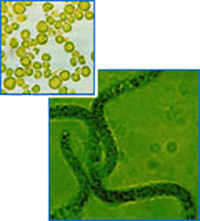Comparison of Spirulina and Chlorella
components
Digestibility and nutritional value.
So much different than Chlorella
Many of you may be wondering how chlorella and spirulina are different.
Indeed, the ingredients, and even the color and shape of tablets are similar. However, there're various differences between, Chlorella, which belongs to chlorophyceae, and Spirulina, which belongs to cyanobacteria. Rather, it can be said that Spirulina was newly introduced as a solution to the drawbacks of Chlorella.
Firstly, the drawback of Chlorella is that it is too small.
The diameter is about 0.3 to 0.5 micron, which is only 1/1000 the size of Spirulina, so it is necessary to use a very complicated method of centrifugation for collection.
In contrast, Spirulina can easily be harvested by filtration. Spirulina is far more suitable for mass production.

Photomicrograph of Chlorella
(upper) and Spirulina(lower)
About 95% digested in 2 hours!
Secondly, Chlorella is a unicellular plant, which has a hard cell wall and is very difficult to digest. In order to be easily digested, it must be mechanically crushed or processed unnaturally, and there is a risk that the ingredients will be damaged.
On the contrary, since Spirulina is multicellular, the cell membrane is soft and easy to be digested without any modification. Therefore, the feces are less likely to turn green.
Please look at the table on the right. It shows the difference in digestibility between Spirulina and Chlorella quite obviously. Chlorella has a digestibility of 12.0% after 1 hour when untreated, and 58.7% even when the cell membrane is destroyed. Spirulina showed a very high digestibility of 80.0% without any treatment and 95.1% after 2 hours.

Artificial digestibility of Spirulina
Nutrition comparison between Spirulina and Chlorella
Also, the table below compares the nutrients of Spirulina and Chlorella.
This table shows that Spirulina is generally more nutritious than Chlorella.
Especially, high content rate of protein, pro Vitamin A, and Vitamin B12. In addition, the dietary fiber content of Chlorella is 2 to 3%, whereas that of Spirulina is about 4 times 8 to 10%.
Component analysis table of Spirulina ・ Chlorella (in 100 g)
|
Spirulina |
Chlorella |
| Isoleucine |
3.25~3.9% |
5.5% |
| Protein |
52~80g |
55~60g |
| Fat |
6.7~8.3g |
10~12g |
| Chlorophyll |
1~2.5g |
1~2g |
| Total carotenoid |
0.2~0.45g |
0.2~0.4g |
| Phycocyanin |
3~9.0g |
0g |
| Potassium |
1,800mg |
1,400mg |
| Calcium |
263~495mg |
200~400mg |
| Phosphorus |
550~1400mg |
300~500mg |
| Magnesium |
200~383mg |
250~300mg |
| Iron |
62~115mg |
50~80mg |
| Pro Vitamin A(β-carotene) |
80~200mg |
0.4~0.5mg |
| Vitamin B1 |
2~5mg |
1~2mg |
| Vitamin B2 |
2~5mg |
4~5mg |
| Vitamin B6 |
0.7~1.3mg |
0.8~1.2mg |
| Vitamin B12 |
0.2~0.4mg |
0.1~0.2mg |
| Vitamin E |
6~12mg |
6~8mg |
| Nicotinic acid |
8~10mg |
8~10mg |
| Inositol |
65~140mg |
80~100mg |
Related products

